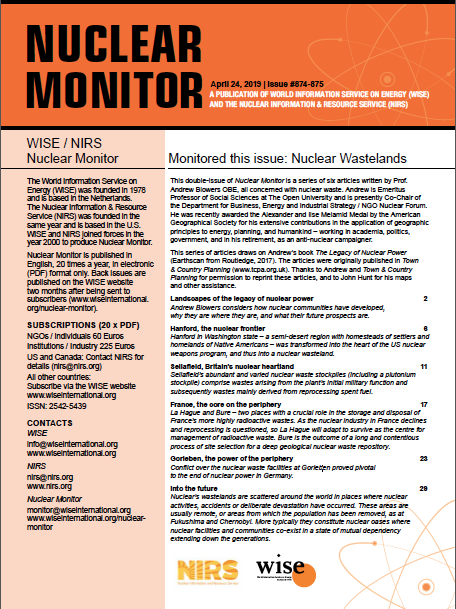 A special double-edition of the Nuclear Monitor, published April 24, 2019, took a look at nuclear waste in depth. It features six articles written by Prof.Andrew Blowers OBE, Emeritus Professor of Social Sciences at The Open University and presently Co-Chair of the Department for Business, Energy and Industrial Strategy / NGO Nuclear Forum. Blowers looks at:
A special double-edition of the Nuclear Monitor, published April 24, 2019, took a look at nuclear waste in depth. It features six articles written by Prof.Andrew Blowers OBE, Emeritus Professor of Social Sciences at The Open University and presently Co-Chair of the Department for Business, Energy and Industrial Strategy / NGO Nuclear Forum. Blowers looks at:
The legacy landscapes of nuclear power, where they are and how they developed: The Hanford Nuclear Reservation, a semi-desert region with homesteads of settlers and homelands of Native Americans ‒ that was transformed into the heart of the US nuclear weapons program, and thus into a nuclear wasteland; Sellafield, Britain’s nuclear heartland. Sellafield’s abundant and varied nuclear waste stockpiles (including a plutonium stockpile) comprise wastes arising from the plant’s initial military function and subsequently wastes mainly derived from reprocessing spent fuel; France, La Hague and Bure -- two places with a crucial role in the storage and disposal of France’s more highly radioactive wastes. As the nuclear industry in France declines and reprocessing is questioned, so La Hague will adapt to survive as the centre for management of radioactive waste. Bure is the outcome of a long and contentious process of site selection for a deep geological nuclear waste repository; Gorleben, where conflict over the nuclear waste facilities proved pivotal to the end of nuclear power in Germany; and a look into the future -- nuclear’s wastelands are scattered around the world in places where nuclear activities, accidents or deliberate devastation have occurred. These areas are usually remote, or areas from which the population has been removed, as at Fukushima and Chernobyl. More typically they constitute nuclear oases where nuclear facilities and communities co-exist in a state of mutual dependency extending down the generations. Read the Nuclear Monitor here.